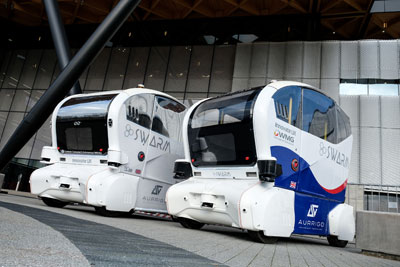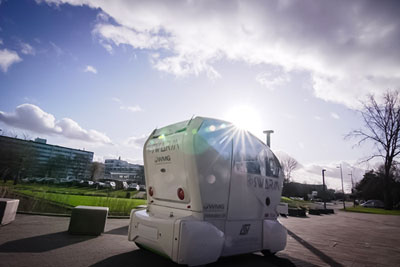Autonomous pods SWARM together like bees
 Driverless pods are one step closer to being put to use as - thanks to Warwick research - they can now help each other to drive and navigate through pedestrian areas around people.
Driverless pods are one step closer to being put to use as - thanks to Warwick research - they can now help each other to drive and navigate through pedestrian areas around people.
Researchers at WMG, working closely with Coventry-based company Aurrigo, have used swarming skills typically used by birds and insects to help pods schedule themselves to form a ‘platoon’, following each other. The team recently showed the move on campus in a world-first demonstration.
What has the research shown?
WMG’s research has developed - having already made sure a single pod can operate safely, the team are now focusing on these key areas:
- Human factors – how do people react to the pods? What do they feel about travelling in them?
- Impact on society – how can pods be commercially viable? What other applications are there for the technology?
Professor Paul Jennings, Intelligent Vehicles Research Lead, explains more:
“We’ve had some really interesting findings to our research. People feel less hurried because there isn’t a driver, and are more comfortable when the pods travel in a ‘platoon’. The ability to swarm is a big step forward – it helps us to get closer to turning the concept into a commercially-viable reality.
We’re also starting to see the potential wider applications of this work in society. For example, pod technology has been trialled for baggage handling at Heathrow airport, which could help both to manage capacity and increase safety for workers.”
How might pods be used?
The pods are designed for pedestrian areas and shared spaces, so public transport can be used on highways and the pods can be used as a ‘first and last mile’ service.
The concept of swarming pods has been well received by the public, with the ultimate idea of using an app to hail a pod, or a platoon of pods if travelling in a group, seen as the next evolution of personal and public transport.
How does it work?
The pods ‘talk’ to a central hub, seeking information and making decisions on where to go next based on what other nearby pods are doing.
Find out more about the research
If you’d like to know more about connected autonomous mobility on campus, contact Alisdair Ritchie, Engagement and Impact Manager, WMG.
